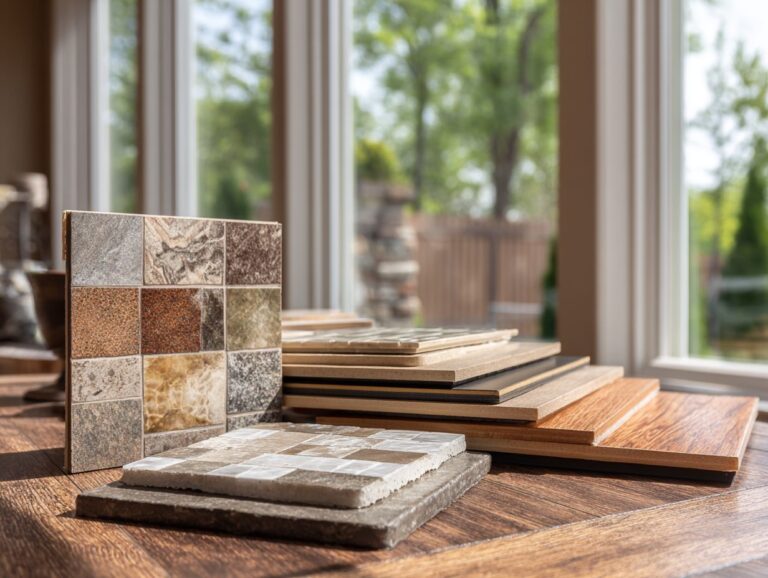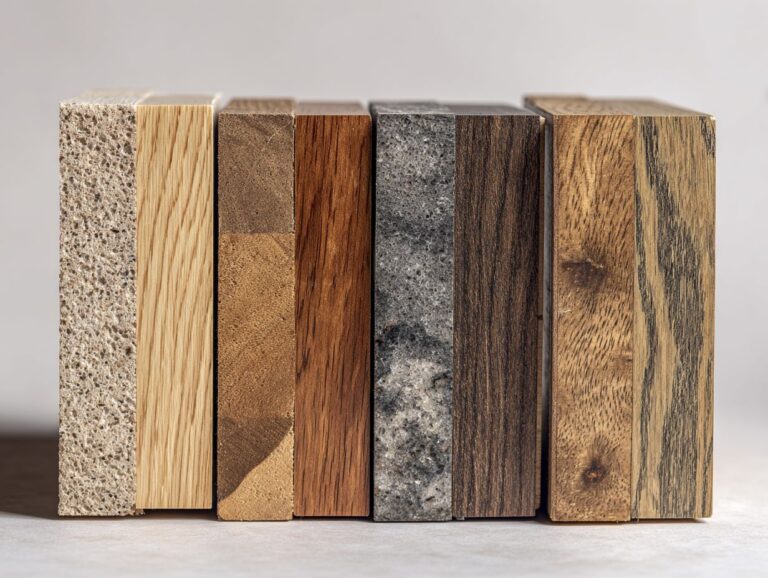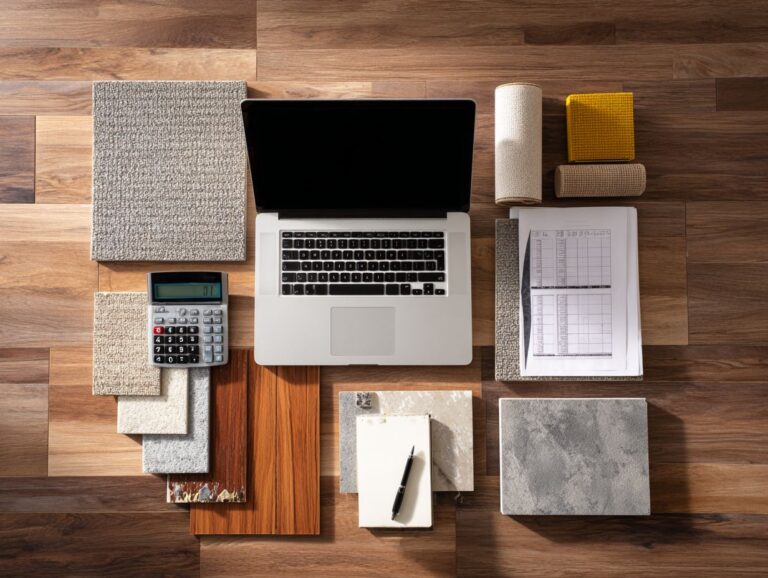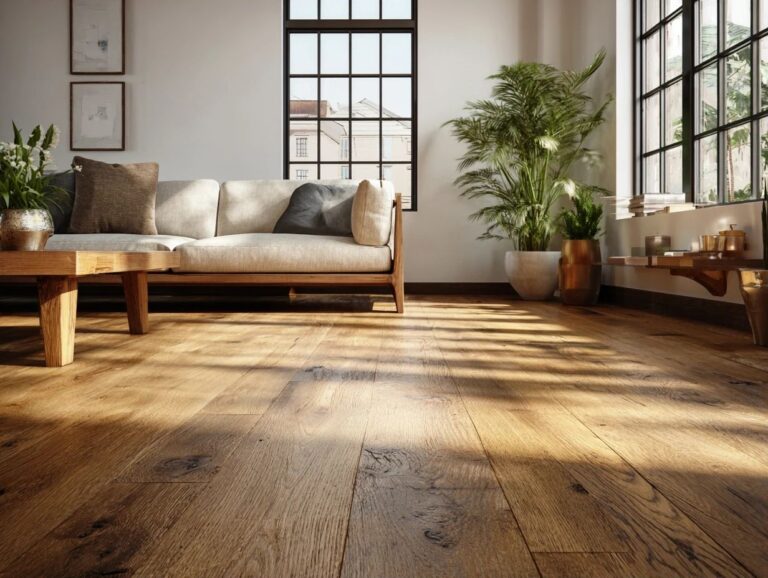Master Bathroom Flooring – Luxury and Functionality
Changing your main bathroom starts with picking the right flooring, combining style with practicality. From beautiful natural stone and rare hardwood to stylish ceramic tiles, each choice enhances the look of luxury homes. Learn how to combine luxury with functionality in your bathroom design, making sure your space is both attractive and long-lasting. This article will guide you through the best high-end flooring choices for creating a serene sanctuary in your home.
Key Takeaways:
Contents
- Types of Flooring Materials
- Luxury Flooring Options
- Luxury Bathroom Flooring Statistics
- Functional Flooring Considerations
- Current Styles in Main Bathroom Flooring
- Installation and Cost Factors
- Frequently Asked Questions
- What are some high-end choices for main bathroom flooring?
- How can we add useful features to the design of a main bathroom floor?
- Can you have flooring in a main bathroom that is both high-end and practical?
- Why choose marble for the main bathroom floor?
- Why does hardwood flooring give a master bathroom a rich feel?
- What are some good-looking and practical green choices for master bathroom flooring?
The Importance of Flooring in Bathroom Design
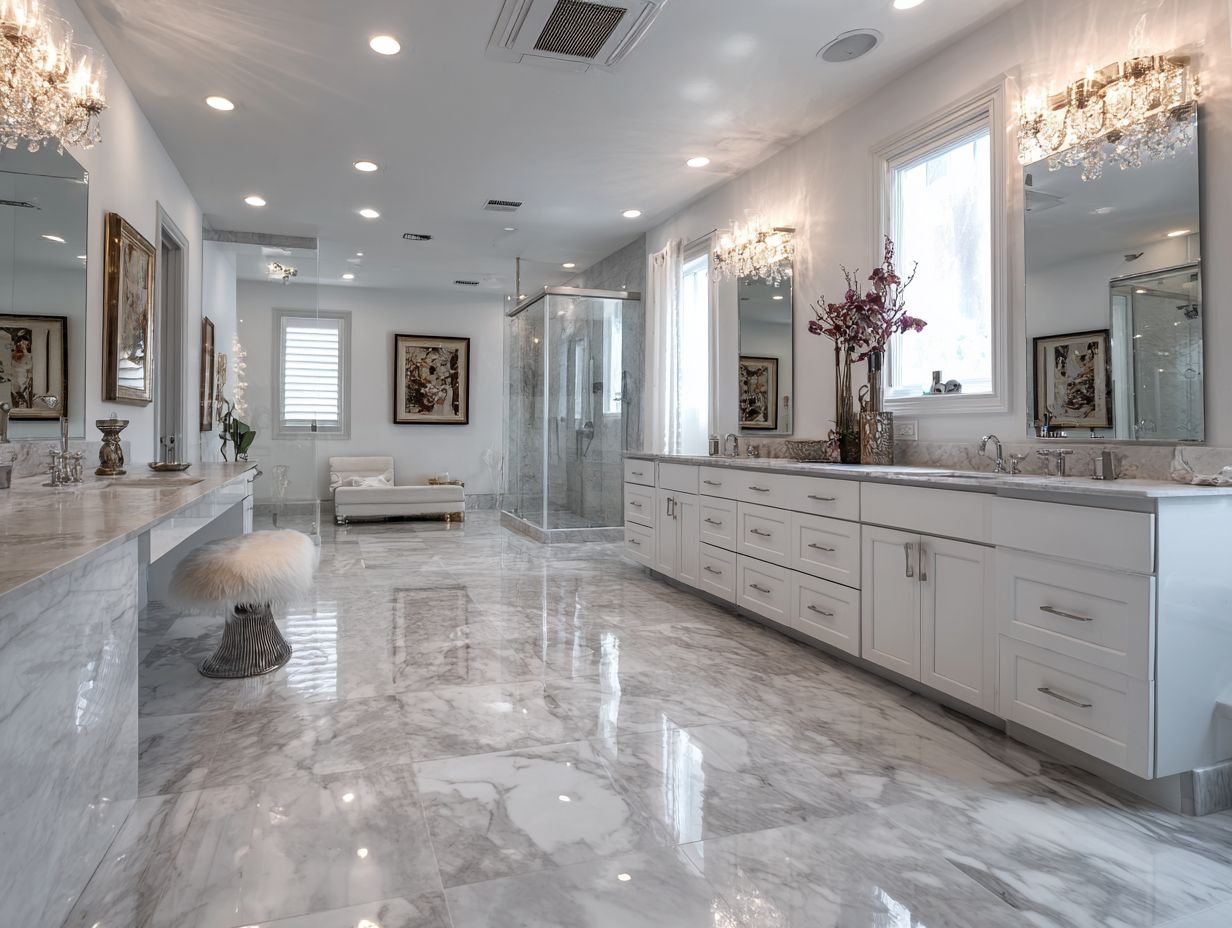
The flooring significantly influences how the main bathroom looks and works.
The right flooring improves the look of a room, makes it more comfortable to walk on, and can increase the home’s resale value.
Using materials like natural stone and high-quality ceramic tiles can greatly improve the look of a bathroom. For example, using large-format porcelain tiles can create a seamless look that visually expands the space, while heated floors provide a luxurious comfort, especially in colder climates.
Using top-grade materials draws in buyers and manages moisture and wear effectively, ensuring they remain durable and attractive for many years.
Balancing Luxury and Functionality
Achieving a balance between luxury and practicality is essential, particularly in a space that endures moisture and foot traffic.
Consider incorporating materials like marble flooring for its stunning appearance and durability.
For areas prone to spills, luxury vinyl tiles offer a water-resistant alternative that is easier to maintain.
Combining these materials allows for high-end design without sacrificing functionality.
A stylish bathroom could feature marble tiles around the tub while using luxury vinyl in the high-traffic areas for longevity.
Also, using rugs made from synthetic fibers can provide comfort underfoot without the worry of water damage.
Types of Flooring Materials
There are various flooring options for main bathrooms that fit different styles, budgets, and practical needs. For those concerned about water damage, exploring waterproof and slip-resistant options can ensure both functionality and safety.
Natural Stone
Natural stone flooring, such as marble, granite, and travertine, provides a unique combination of style and strength for bathroom spaces.
The cost of installation varies significantly, typically ranging from $5 to $20 per square foot, depending on the stone type and cutting complexity.
Marble looks fancy, but it stains more easily than granite. Granite is better for places with more use.
To maintain your stone flooring, weekly cleaning with a pH-neutral stone cleaner is essential, followed by periodic sealing to prevent moisture penetration. This care keeps the stone looking good and makes it last much longer.
Porcelain and Ceramic Tiles
Porcelain and ceramic tiles are popular choices due to their versatility, stylish designs, and water-resistant properties.
When choosing between porcelain and ceramic, consider their application. Porcelain tiles are thicker and are great for places with heavy use and outside areas. Ceramic tiles are better for areas with less use, such as bathrooms and kitchens. Worth exploring: Our Bathroom Flooring Guide details waterproof and slip-resistant options that perfectly complement ceramic tiles in these environments.
For installation, opt for thin-set mortar for both types; it’s durable and allows for easy adjustments. Choose the correct grout; a good, water-resistant grout makes your tiles last longer and stops mold, keeping them looking great for years.
Vinyl Flooring
Luxury vinyl tiles provide a stylish yet affordable flooring alternative that is highly water-resistant and easy to maintain.
With costs ranging from $2 to $5 per square foot, LVP is a budget-friendly option compared to hardwood or ceramic tiles.
Installation can often be a DIY project, requiring minimal tools like a utility knife and straight edge.
In scenarios such as family bathrooms, LVP shines due to its water resistance and durability against high traffic.
Regular upkeep includes sweeping and mopping sometimes, which is easy for families with a hectic schedule.
Its design versatility means it can mimic hardwood or stone, offering aesthetic flexibility without compromising functionality.
Hardwood Flooring
While hardwood flooring offers warmth and natural beauty, its suitability for bathrooms requires careful consideration of water exposure.
Engineered wood is a good choice for bathrooms because it has a plywood base with a hardwood top layer, which makes it more resistant to moisture than solid wood.
To protect your flooring, apply a high-quality polyurethane sealant, focusing particularly on seams and edges where water can seep in. Cleaning up spills quickly and using a humidifier in dry weather can help your hardwood flooring last longer.
Avoid standing water by placing rugs at entry points to absorb excess moisture.
Laminate Flooring
Laminate flooring is an economical option that mimics the appearance of wood or stone while offering good resistance to moisture.
Installing laminate flooring in wet areas requires special attention to detail to avoid warping. Start by selecting a high-quality underlayment, like moisture-resistant foam, which typically costs between $0.50-$1 per square foot.
Make sure the surface is clean and dry before starting the installation. Use a water-resistant adhesive for seams and consider adding a polyurethane sealant afterward for added protection.
Maintain proper humidity levels in the room to prevent excess moisture, ideally between 30-50%, to prolong the life of your flooring.
Carpet in Bathrooms
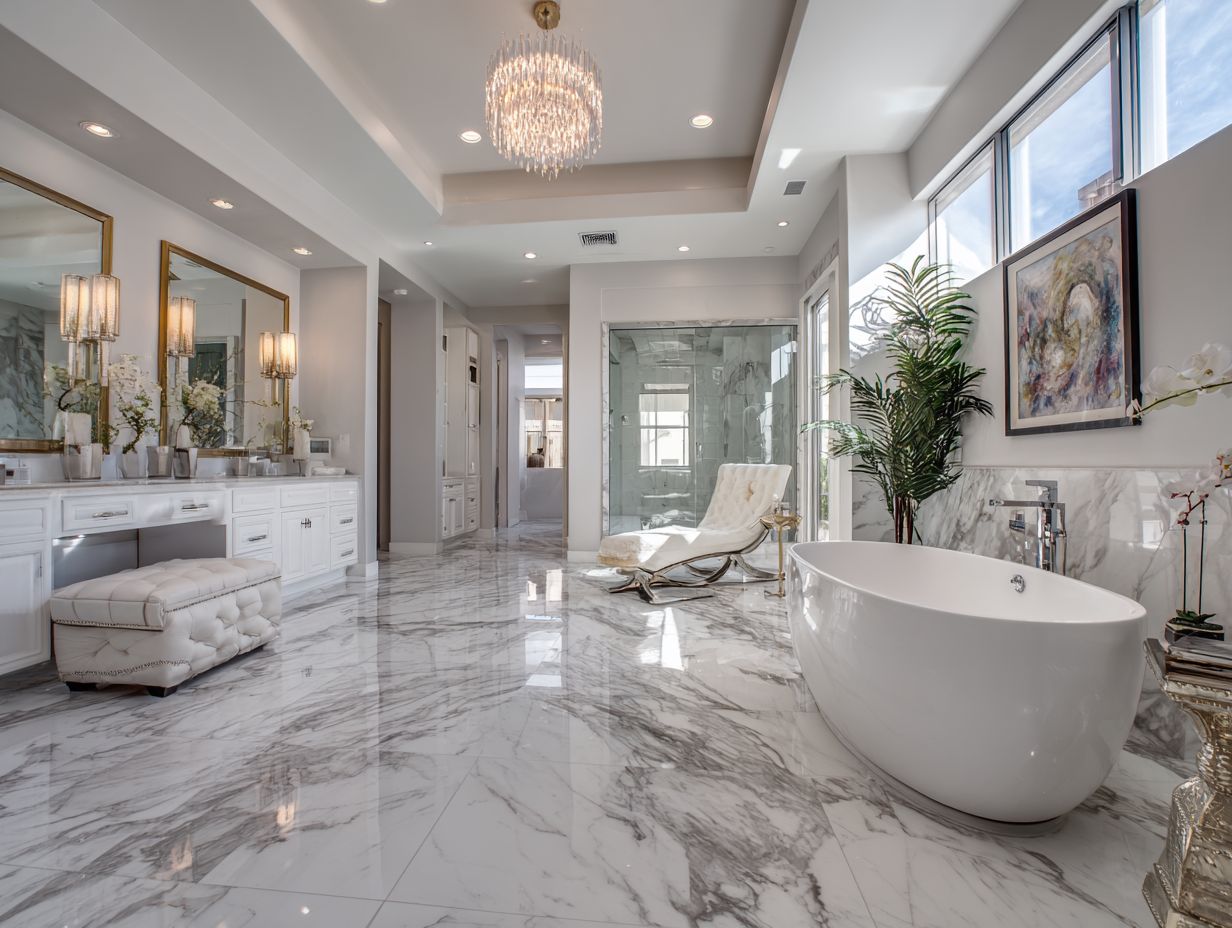
Using carpet in bathrooms can add comfort, but it poses significant challenges in terms of moisture and cleaning.
- To effectively use carpet in bathrooms, consider moisture-resistant options like nylon or polypropylene. These materials are designed to withstand damp environments.
- For maintenance, treat carpets with anti-microbial sprays to prevent mold and mildew growth. Regular vacuuming and periodic steam cleaning can help keep the fibers free from grime and odor.
- Ideal use cases include small area rugs near sinks or tubs, where you can add a cozy feel without overwhelming the space.
Always keep the area well-ventilated to help with drying and keeping things fresh.
Luxury Flooring Options
High-end flooring choices improve the look of main bathrooms and increase the overall worth of a home. For those considering their options, our hidden gem on vinyl flooring types offers valuable insights into making an informed decision.
Luxury Bathroom Flooring Statistics
Luxury Bathroom Flooring Statistics
Market Growth and Composition: Market Size
Market Growth and Composition: Resilient Flooring Growth
Market Growth and Composition: Luxury Vinyl Tiles (LVT) Influence
Market Growth and Composition: Rigid Core Flooring Impact
The Luxury Bathroom Flooring Statistics give a clear summary of the latest trends and forecasts in the market for high-end bathroom flooring options. This information shows important growth trends and the importance of certain flooring types, such as resilient flooring, luxury vinyl tiles (LVT), and rigid core flooring, in influencing the industry’s development.
Market Growth and Composition indicate a significant expansion in the luxury bathroom flooring sector, with a market value of $25.6 billion in 2024. This is expected to rise substantially to $39.8 billion by 2033, reflecting strong consumer demand driven by increasing home renovation projects and the desire for high-end, durable flooring solutions.
- Resilient Flooring Growth: The data shows impressive growth for resilient flooring, with 2022 dollar sales increasing by 34% and volume growth at 31.64%. More people are choosing flooring that is long-lasting and easy to care for, attracting those who want both practical use and comfort.
- Luxury Vinyl Tiles (LVT) Influence: LVT continues to be a dominant force within the luxury flooring market, with 2022 dollar sales growth of 14.1% and a substantial 69% market dollar share. Its popularity is likely due to its aesthetic versatility, replicating the look of wood or stone at a lower cost and with greater resilience.
- Rigid Core Flooring Impact: Rigid core flooring also plays a major role, holding a 60% share of 2022 dollar sales and a 47% volume share. Known for its stability and waterproof features, rigid core flooring is ideal for bathrooms, offering consumers a blend of durability and luxury design.
The Luxury Bathroom Flooring Statistics Highlight the rapid expansion and changing makeup of the market. As people start choosing tougher and better-looking products, the industry is set to keep growing. Advancements in materials and design are expected to continue driving this growth, keeping luxury flooring options attractive in current home design.
Benefits of Natural Stone
Natural stone brings long-lasting charm, strength, and a distinct look to any main bathroom’s design.
Adding natural stone can greatly improve your main bathroom. Granite and quartzite resist scratches and stains. They are easy to care for, needing just regular sealing.
On the other hand, marble looks nice but absorbs liquids easily and needs regular maintenance. Consider pairing stone with radiant floor heating for added luxury and comfort, which can be installed during the renovation process.
Natural stone is more durable than synthetic materials and can last for many years with proper care.
High-End Tile Designs
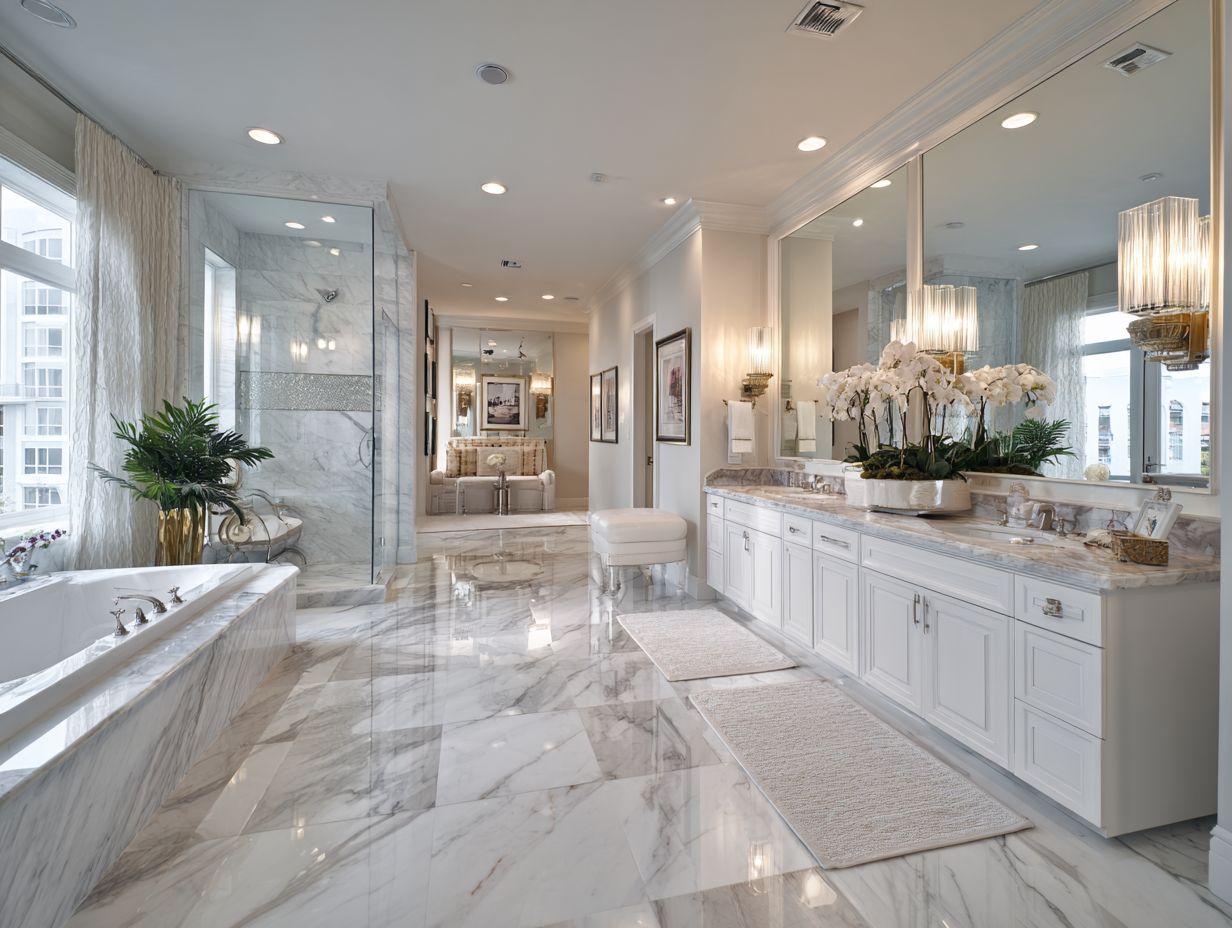
Fancy tile designs use detailed patterns and textures to change an ordinary bathroom into a luxury getaway.
For instance, consider geometric patterned tiles that add a modern twist; options like the Encaustic Cement Tile start around $5 per square foot. Large-format tiles, such as those from the rectified ceramic collection, create a seamless look and can cost between $8 and $15 per square foot.
Pair these with textured finishes like matte or glossy for added depth. These choices improve the look and help create a unified design that encourages a calm, spa-like feel.
Luxury Vinyl Plank (LVP)
Luxury Vinyl Plank (LVP) looks like wood but is as useful as vinyl, making it ideal for bathrooms.
One of the standout benefits of LVP is its water resistance, essential in areas prone to moisture. For instance, styles like Shaw’s Floorte ($3-$5 per sq. ft.) and COREtec ($4-$7 per sq. ft.) are designed specifically for wet environments, ensuring longevity and reducing maintenance issues.
The installation process for LVP is simple. A lot of homeowners pick the click-lock method, allowing them to install it on their own. Typical expenses for LVP, with installation included, generally fall between $5 and $10 per square foot, making it a budget-friendly flooring choice.
Functional Flooring Considerations
When picking floors for main bathrooms, consider both practicality and appearance to achieve safety and effectiveness.
Water Resistance and Durability
Water resistance and durability are paramount in bathroom flooring due to constant exposure to moisture.
When selecting bathroom flooring, consider materials like porcelain tiles, vinyl, and natural stone.
Porcelain tiles are excellent at resisting water, often receiving the top score of 5 in performance tests, which makes them perfect for use in wet areas.
Vinyl, with its 100% moisture barrier, is a budget-friendly option that can withstand spills, though it generally receives a 3 out of 5 rating.
Natural stone, while beautiful, varies in resistance-slate performs better than marble. Always assess your specific environment and choose materials that will maintain their integrity over time.
Slip Resistance
It’s important to prevent bathroom floors from becoming slippery to avoid accidents in wet areas.
To achieve optimal slip resistance, consider textured ceramic or porcelain tiles, which often feature coatings designed to improve grip. For example, Daltile’s slip-resistant tiles have a special surface treatment that greatly improves grip.
Alternatively, luxury vinyl tiles (LVT) offer both aesthetics and safety; products like Karndean Designflooring often combine wood or stone looks with textured finishes for better grip.
When installing, make sure grout lines are completely filled. Uneven surfaces can cause safety risks. Regular cleaning also helps maintain the slip-resistant properties over time.
Maintenance and Cleaning
Picking flooring that is simple to clean can help keep a main bathroom looking spotless without much time or work.
For an effortless maintenance routine, consider these flooring options:
- Luxury Vinyl Plank (LVP) should be swept and cleaned with a damp mop and a pH-neutral cleaner every few weeks.
- Porcelain tiles are durable but need regular mopping with a mild detergent, ideally weekly to prevent grime buildup.
- On the other hand, laminate flooring can be cleaned with a microfiber mop and a gentle cleaner, following a bi-weekly schedule for best results.
Following these steps keeps each flooring type in great shape and improves the look of your bathroom.
Current Styles in Main Bathroom Flooring
Keeping up with design trends can help homeowners select bathroom flooring that matches modern styles and their own preferences.
Color Schemes and Patterns
Color schemes and patterns can dramatically influence the ambiance of a bathroom, creating a cohesive and inviting space.
For a classic and stylish look, try mixing soft white colors with deep navy blue shades. Alternatively, muted greens alongside gleaming brass accents can evoke a calming spa-like environment.
Popular trends feature geometric tiles that bring lively texture, like herringbone patterns in floor tiles, matched with simple wall colors.
Tools like paint sample apps can help visualize combinations before committing, while physical samples allow for tactile comparisons of materials. Trying out these color schemes can turn your bathroom into a peaceful escape.
Mixing Materials for Visual Interest
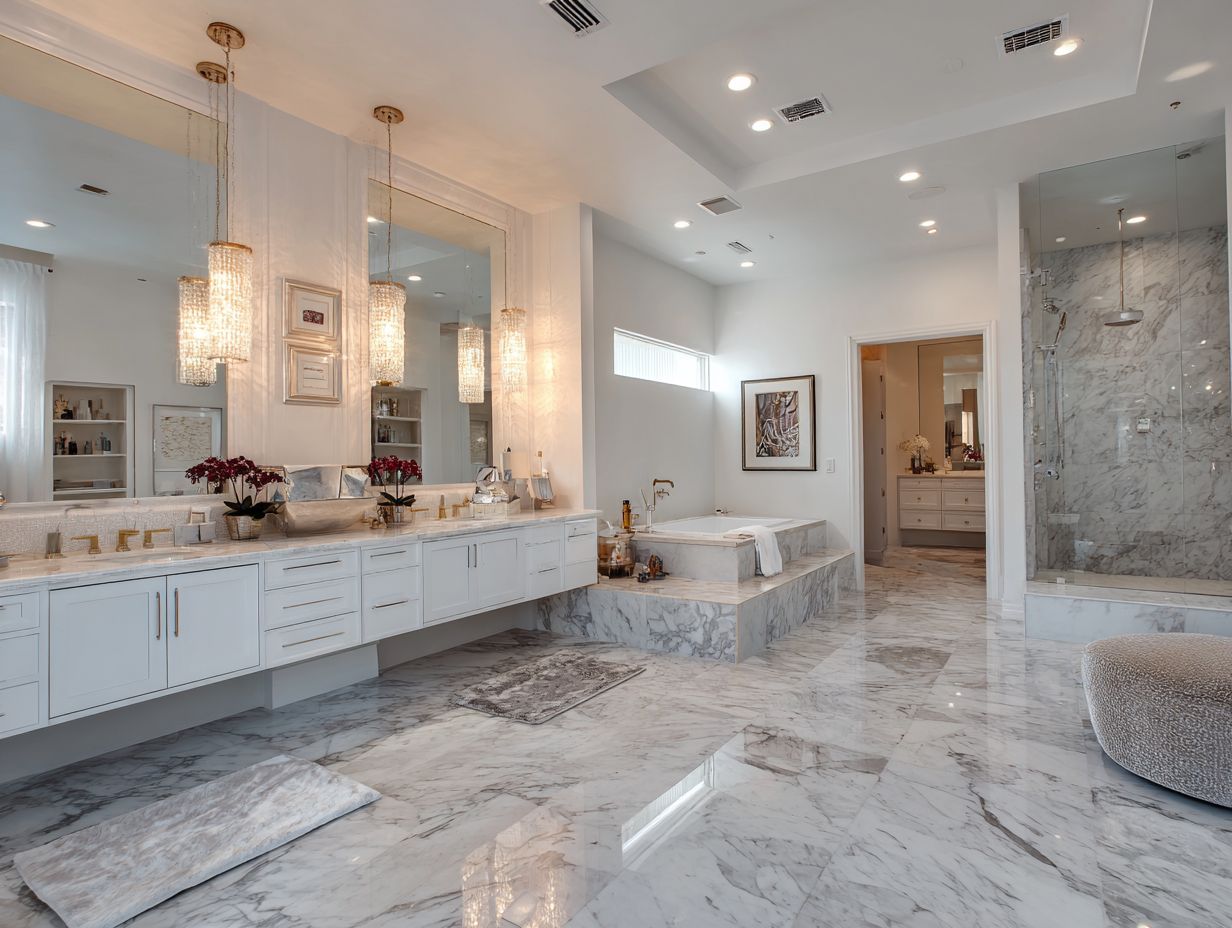
Picking various flooring options can make main bathrooms look more appealing and special.
To achieve a harmonious blend, consider pairing textured natural stone tiles with warm wood-look vinyl planks. For instance, using large, slate-style tiles around the shower area can contrast beautifully with oak laminate flooring, which suits the rest of the bathroom.
Use a smooth transition strip for a clean finish. Choosing different tile sizes-such as 12×24 tiles for the walls and smaller mosaics for the floor-can improve the design, highlighting certain areas and attracting attention throughout the room.
Installation and Cost Factors
Knowing the costs and installation steps of different flooring choices can help homeowners choose wisely. For example, understanding the nuances of various options like waterproof and slip-resistant materials is crucial when considering spaces prone to moisture.
Related insight: Bathroom Flooring Guide – Waterproof and Slip-Resistant Options
Professional vs. DIY Installation
Choosing between professional installation and DIY can impact the overall cost and outcome of your bathroom flooring project.
Professional installation guarantees a polished result, saving you from mistakes that might arise during a DIY project. It can range from $3 to $10 per square foot, depending on material complexity.
In contrast, DIY costs primarily involve materials, often reducing total expenses to $1 to $5 per square foot. For example, vinyl plank tiles are beginner-friendly and can be laid down without adhesives, while ceramic might require specialized tools.
Assessment of your skills and budget should guide your choice, balancing cost against your desire for a flawless finish.
Budgeting for Luxury Flooring
Planning your spending wisely for high-end flooring helps you get the look you want without going over your budget.
To create a solid budget, start by researching flooring types. Hardwood averages $8-$15 per square foot, while luxury vinyl can range from $2-$7.
Consider installation costs too; professionals may charge $3-$5 per square foot, depending on complexity. For maintenance, allocate about $0.50 per square foot annually for cleaning products and repairs.
Focus on important features and avoid fancy extras to stay within your budget. Look for vendors offering discounts or take advantage of sales events. This structured approach can help you achieve both beauty and functionality within your financial plan.
Frequently Asked Questions
What are some high-end choices for main bathroom flooring?
Some top-quality options for main bathroom flooring are marble, granite, travertine, porcelain, and hardwood.
How can we add useful features to the design of a main bathroom floor?
You can make the flooring in the main bathroom practical by selecting materials that resist water, are simple to clean, and prevent slipping.
Can you have flooring in a main bathroom that is both high-end and practical?
Choose durable and attractive materials made for bathrooms to design a practical and elegant main bathroom floor.
Why choose marble for the main bathroom floor?
Marble is a common option for main bathroom floors because it feels luxurious, is strong and durable, and is available in many colors and designs.
Why does hardwood flooring give a master bathroom a rich feel?
Wood floors can give a main bathroom a sophisticated appearance by making it feel warm and inviting. They can be stained or finished in various styles to match any design.
What are some good-looking and practical green choices for master bathroom flooring?
Yes, there are eco-friendly choices for main bathroom flooring like bamboo, cork, or reclaimed wood, which give a sense of luxury and are also strong and easy to care for.
